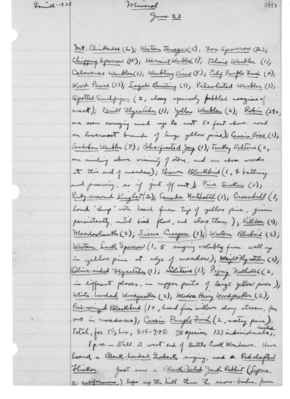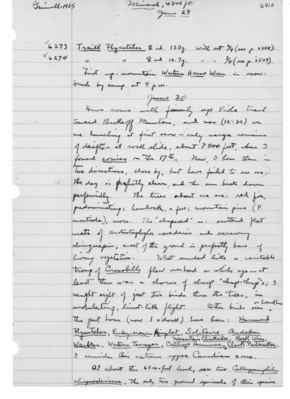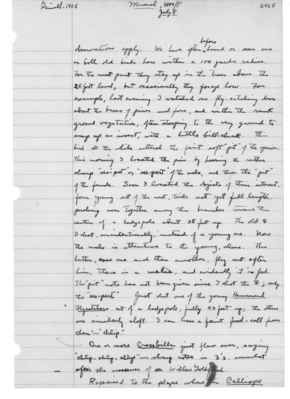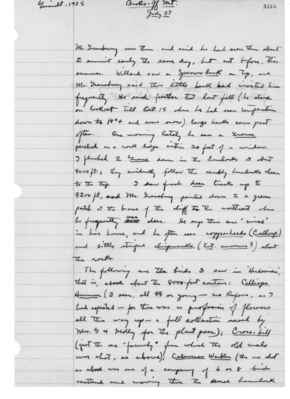Pages That Mention Red Crossbill
1925: Joseph Grinnell's field notes
S2 Page 39
Collector: Grinnell - 1925 Location: Mineral Date: June 23 Page Number: 2493
Mt. Chickadee (2); Western Tanager (5); Fox Sparrow (2); Chipping Sparrow (18); Hermit Warbler (3); Tolmie Warbler (1); Calaveras Warbler (1); Warbling Vireo (8); Calif. Purple Finch (4); Wood Pewee (13); Lazuli Bunting (3) Pileated Warbler (1); Spotted Sandpiper (2, along sparsely pebbled margins of creek); Traill Flycatcher (1); Yellow Warbler (2); Robin (29+, one seen carrying mud up to nest 50 feet above and on lowermost branch of huge yellow pine); Cassin Vireo (1); Audubon Warbler (7); Blue-fronted Jay (1); Turkey Vulture (2, one circling above vicinity of store (?), and one above woods at this end of the meadow) Brewer Blackbird (1, [female symbol] bathing and preening, as if just off nest); Pine Siskin (1); Ruby-crowned Kinglet (2); Canada Nuthatch (1); Crossbill (1, loud "chup" note heard from tips of yellow pine, given persistently, until bird flew, and also then); Killdeer (2); Meadowlark (2); Sierra Creeper (1); Western Bluebird (2); Western Lark Sparrow (1, [male symbol] singing volubly from well up in yellow pine at edge of meadow); Wright Flycatcher (2); Olive-sided Flycatcher (1); Solitaire (1); Pygmy Nuthatch (2, in different places, in upper parts of large yellow pines); White-headed Woodpecker (2); Modoc Hairy Woodpecker (2); Red-winged Blackbird (1+, heard from willows along stream, far out in meadows); Cassin Purple Finch (2, mating pair).
Total, for 1 1/2 hrs., 8:15-9:45: 38 species, 133 individuals.
1 p.m. Still at west end of Battle Creek Meadows. Have heard a Black-headed Grosbeak singing, and a Red-shafted Flicker. Just saw a Black-tailed Jack Rabbit (Lepus c. californicus) lope up the hill thru the snow bushes, from
S2 Page 57
Collector: Grinnell - 1925 Location: Mineral, 4800 ft. Date: June 29 Page Number: 2510
6273 Traill Flycatcher [female symbol] ad. 13.0 g. with set 3/4 (see p. 2508). 6274 Traill] [Flycatcher] [female symbol] ad. 12.7 g. [with] [set] 3/4 (see p. 2509).
First up - mountain Western House Wren in snow brush by camp at 4 p.m.
June 30 Have come with family up Viola trail towards Brokeoff Mountain, and now (12:30) we are lunching at first snow - only meagre remains of drifts - at rock slide, about 7500 feet, where I found conies on the 17th. Now, I hear them in two directions, close by, but have failed to see one. The day is perfectly clear, and the sun beats down perfervidly. The trees about me are: red fir, predominating; hemlock, a few; mountain pine (P. monticola), more. The "chaparral" is: scattered flat mats of arctostaphylos nevadensis and scrawny chinquapin; most of the ground is perfectly bare of living vegetation. What sounded like a veritable troup of Crossbills flew overhead a while ago - at least there was a chorus of sharp "chup-chup's"; I caught sight of just two birds thru the trees, in undulating, linnet-like flight. Other birds seen ^or heard here the past hour (now 1 o'clock) have been: Hammond Flycatcher, Ruby-crown Kinglet, Solitaire, Audubon Warbler, Western Tanager, Calliope Hummer,^ Mountain Chickadee, Rock Wren, Clark Nutcracker. I consider this extreme upper Canadian zone.
At about 6500-foot level, saw two Callospermophilus chrysodeirus, the only two ground squirrels of this species
S2 Page 72
Collector: Grinnell - 1925 Location: Mineral, 4800 ft. Date: July 8 Page Number: 2525
observation apply. We have often ^before head or seen one or both old birds here within a 100 yards radius. For the most part they stay up in the trees above the 25-foot level, but occasionally they forage. For example, last evening I watched one fly-catching down about the bases of pines and firs, and within the rank ground vegetation, often stooping to the very ground to snap up an insect, with a little bill-click. This bird all the while uttered the faint soft "pit" of the species. this morning I located the pair by hearing the rather sharp "see-put" or "see-pert" of the male, and then the "pit" of the female. Soon I located the objects of their interest, four young out of the nest, tails not yet full length, perching near together among the branches toward the center of a lodgepole about 25 feet up. The old [female symbol] I shot, unintentionally, instead of a young one. The latter, now one and then the other, fly out after him, there is a melee, and evidently it is fed. The "pit" note has not been given since I shot the [female symbol], only the "see-pert." Just shot one of the young Hammond Flycatchers out of a lodgepole, fully 40 feet up; the others are similarly aloft. I can heard a faint food-call from them - "chlip."
One or more Crossbills just flew over, saying "chup - chup - chup" - sharp notes in 3's, somewhat after the manner of a Willow Goldfinch.
Repaired to the place where the Calliope
S2 Page 77
Collector: Grinnell - 1925 Location: Mineral, 4800 ft. Date: July 26 Page Number: 2530
of the nest she has under observation - Robin ^(2 eggs), Wright Flycatcher ^(3 eggs), Green-tailed Towhee (3 small young). She is keeping full, formal notes on all these, so I won't repeat. The most astonishing thing is the second set of eggs of Wright Flycatcher in the same nest a brood of 4 was raised in, this season. As far as I can see, the nest is in excellent condition, clean and compact; of course is might have - probably was - re lined and otherwise renovated at the beginning of the second mating.
Jumped a fawn here by camp, from a lying-down place under a very small fir surrounded by dense ceanothus cordulatus save for a poorly marked entrance gangway. The deer somehow got thru [sic] the mass of entanglements opposite me as I came in along the "gangway"; I noted mentally that it was a "jack rabbit" until it bounded into the open beyond, behaving, in movements, just like an old deer, tho it certainly wasn't more than 1/4 grown.
6293 Calaveras Warbler [male symbol] im. 8.1g. Shot out of hemlock, 25 feet up, where looked much larger than it proved to be.
6294 Sierra Crossbill [male symbol] ad. 29.6g. Shot out of top of hemlock about 25 feet above steeply sloping mountain-side. Testes [testes illustration]. With at least 5 others scattered about in tops of closely adjacent hemlocks, these latter abundantly producing the green pendant cones. I was mentally sure the crossbills were feeding on these cones; if even when skinning the bird shot, and I
S2 Page 79
Collector: Grinnell - 1925 Location: Broke-off Mt. Date: July 27 Page Number: 2532
Mr. Gransbury saw them and said he had seen them about the summit early the same day, but not before, this summer. Willard saw a Sparrow Hawk on top, and Mr. Gransbury said this little hawk had visited him frequently. He said further that the last fall (he staid on lookout till Oct. 15 when he had seen temperatures down to 14°+ and some snow) large hawks came past often. One morning lately he saw a Grouse perched on a rock ledge within 20 feet of a window. I flushed 2 Grouse down in the hemlock at about 9000 ft.; they evidently follow the scrubby hemlocks cleans to the top. I saw fresh deer tracks up to 9200 ft., and Mr. Gransbury pointed down to a green patch at the base of the cliff to the northeast where he frequently sawsees deer.He says there are "mice" in his house and he often sees copperheads (Callosp.) and little striped chipmunks (Eut. amoenus?) about the rocks. The following are the birds I saw in "Hudsonian" that is, about the 8000-foot contour: Calliope Hummer (3 seen, all [female symbol] [female symbol] or young - no Rufous, as I had expected - for there was a profusion of flowers all the way up - a full collection saved by Mrs. G. & Molly for the plant press); Cross-bill (just the one "family" from which the old male was shot, as above); Calaveras Warbler (the one shot as above was one of a company of 6 or 8 birds scattered and moving thru [sic] the dense hemlock




